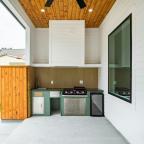
More Than Just a Pool: The Hidden Healing Tricks of Colour in Spas
Spa season is here, and we’re all in dire need of a truly relaxing wellness experience! There is nothing more satisfying than slipping on your tan sandals and sundress and heading for a day or vacation that pampers your mind, body, and soul.
Whether at home or abroad, spas are designed to nurture you, so that you can find your inner calm and feel rejuvenated. A range of facilities, such as mineral baths, experience showers, steam rooms, and massages, all contribute to the serene spa experience.
But did you know that the spa and wellness centres have another hidden trick to induce your tranquil state? It’s called colour therapy.
What is colour therapy?
People have known about the healing properties of colours since ancient times. "It's been said that Hippocrates understood the power of colour and used coloured ointments on his patients," said Eleyne Austen Sharp, founder of the Aura House in Rhode Island and a certified colour therapist.
Colour therapy, also known as chromotherapy, is based on the notion that each colour has its own frequency, just like sound. Retrospectively, our energetic body, also called aura, is composed of seven energetic centres, chakras, each responsible for a different emotion and body part. Each chakra is representative of one of the seven main colours.
When we’re exposed to different wavelengths of colour, they correspond with certain chakras. As a result, certain chemicals in our brain that control pain and stress are enhanced and released, making us feel less pain and anxiety. Colour therapy restores our emotional and physiological balance, helping us feel at ease. It has great use in calming the mind and treating depression, anxiety, insomnia, and other psychological disorders.
How effective is colour therapy?
"Colour is one of best natural medicines around," said Eleyne Austen Sharp. And it’s a part of our daily lives, whether we realise it or not.
In a sense, we are all colour therapists. When we want to induce more cheer and confidence into our lives, we naturally gravitate towards yellow clothes, because yellow represents self-esteem. Back in the day, schools used to have green boards instead of the classic whiteboard, because green was known to have calming properties. Prison inmates in Texas have to wear pink, the colour of the womb, because it is said to reduce levels of aggression.
A 2019 study by I. Ifdil et al. examined the effectiveness of colour therapy to reduce the anxiety of elementary school students about mathematics. The results showed that chromotherapy reduced students’ anxiety from a very heavy category to a light category, therefore proving effective.
Nowadays, interior designers are eager to learn about the meanings of different colours in order to satisfy not only their clients’ aesthetic preferences but also their emotional needs. That feeds into the design of spa and wellness centres too.
Colour therapy in spa and wellness centres
According to colour therapists, colour can enter our bodies either through our eyes or skin.
It’s believed that when we look at certain colours, our brains react to them and induce the relevant hormones, resulting in a certain state of mind. Not all colours are calming though. Warm colours tend to have stimulating effects, while cool tones induce tranquillity.
In spa and wellness centres, for example, you will rarely find lots of red colours in the interior design. While red is related to the root chakra and represents grounding and reinvigoration, it can also trigger people who are already susceptible to tension.
Greens and blues, on the other hand, have incredibly calming properties and are actively used to treat depression and anxiety. Blue is “the colour of peace, serenity, communication, and truth. The energy of blue can also help lower your blood pressure" due to its association with the sea and the sky, according to Sharp. Green is associated with the heart chakra, so it can promote equilibrium and extend its healing properties to your heart, lungs, and circulatory system.
The Grayshott Spa in Surrey, for example, provides an all-immersive wellness experience, powered by the healing properties of colour. Located in a manor house that was once the home of Poet Laureate Lord Alfred Tennyson and rooted in the countryside, the venue offers an abundance of greenery. The pool itself features a deep blue metallic wave-like ceiling matched with white walls – the colour of purity and cleanliness.
As we mentioned, colour can also be perceived through the skin. In colourpuncture, certain colour lights are shone onto particular acupressure points through LED lightboxes. It can be especially beneficial in treating some serious ailments. Ultraviolet light, for example, is used in the treatment of skin diseases, such as eczema and psoriasis. Blue light can help with SAD (seasonal affective disorder), due to its ability to affect the circadian rhythms. It’s also used in facial light treatments, and blue is believed to help with congested skin. Carla Bruni and Jennifer Aniston are fervent fans of light therapy.
It turns out that colour deserves much more credit than what we give it. Once we master the science of colour therapy, we can revel in the healing properties of the gamut of tones that are all around us and enjoy a balanced and fulfilling life!
Sources
https://www.astroyogi.com/spirituality/color-therapy?msclkid=42c05aeeb5b511ecba8979df70ceda62
https://www.chakras.info/chakra-colors/
https://goodspaguide.co.uk/features/colour-therapy?msclkid=42c02054b5b511eca3e1e5c4ff53b77f
https://iopscience.iop.org/article/10.1088/1742-6596/1175/1/012183
https://www.spabreaks.com/venues/grayshott-spa?msclkid=037c5651b64e11ecbf7bc0ebd55d2ece
https://goodspaguide.co.uk/features/colour-therapy?msclkid=42c02054b5b511eca3e1e5c4ff53b77f










